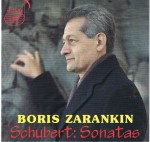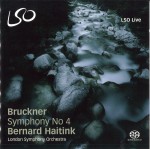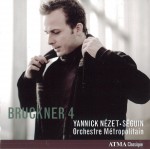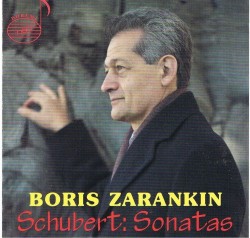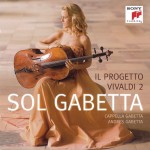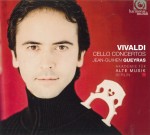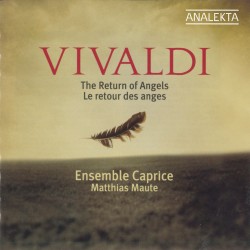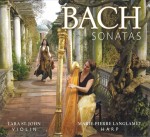 The Canadian violinist Lara St. John, by her own admission, never managed to really connect with the Bach Sonatas for Violin and Harpsichord; somehow, she says, she “never thought they quite clicked,” either with harpsichord or modern piano accompaniment. Several years ago, when St. John was staying in Berlin with Marie-Pierre Langlamet, the principal harpist of the Berlin Philharmonic since 1993, the two read through some Bach sonatas. It was, says St. John, “a revelation.” Bach Sonatas, her new CD with Langlamet on her own Ancalagon label (ANC 139) is the result, and it is, indeed, a revelation. The switch from harpsichord to harp is obviously the major factor here. There might be very little dynamic range on the keyboard instrument, but it’s scarcely any bigger on the harp. Moreover, the crisp, precise incision of the note attack on the harpsichord is replaced by a softer, gentler and more luminous sound on the harp, especially in the bass lines of the lower register. This completely changes the nature of the accompaniment, and poses significant questions for the violinist: straightforward, by-the-numbers playing, especially in the faster contrapuntal passages, simply won’t work anymore. St. John, however, has the perfect answer, playing not only with unerring accuracy but also with a wonderfully expressive sensitivity, almost as if thoughtfully probing and exploring the music rather than simply presenting it. It’s intelligent and nuance-filled music-making of the highest level, and matched for both nuance and sensitivity by Langlamet.
The Canadian violinist Lara St. John, by her own admission, never managed to really connect with the Bach Sonatas for Violin and Harpsichord; somehow, she says, she “never thought they quite clicked,” either with harpsichord or modern piano accompaniment. Several years ago, when St. John was staying in Berlin with Marie-Pierre Langlamet, the principal harpist of the Berlin Philharmonic since 1993, the two read through some Bach sonatas. It was, says St. John, “a revelation.” Bach Sonatas, her new CD with Langlamet on her own Ancalagon label (ANC 139) is the result, and it is, indeed, a revelation. The switch from harpsichord to harp is obviously the major factor here. There might be very little dynamic range on the keyboard instrument, but it’s scarcely any bigger on the harp. Moreover, the crisp, precise incision of the note attack on the harpsichord is replaced by a softer, gentler and more luminous sound on the harp, especially in the bass lines of the lower register. This completely changes the nature of the accompaniment, and poses significant questions for the violinist: straightforward, by-the-numbers playing, especially in the faster contrapuntal passages, simply won’t work anymore. St. John, however, has the perfect answer, playing not only with unerring accuracy but also with a wonderfully expressive sensitivity, almost as if thoughtfully probing and exploring the music rather than simply presenting it. It’s intelligent and nuance-filled music-making of the highest level, and matched for both nuance and sensitivity by Langlamet.
This is by no means a complete set of the six sonatas. The performers chose sonatas where the keyboard part could be played as written (and the harpsichord parts for these works were fully written out, and not just a figured bass part) with no need for transcription for the harp. Two violin sonatas – No.1 in B Minor BWV1014 and No.3 in E Major BWV1016 – are here, together with the Flute Sonatas in G Minor BWV1020 (possibly not written by Bach) and in B Minor BWV1030, and the Siciliana from the Flute Sonata in E-Flat Major BWV1031.
Beautifully recorded in Berlin, the result is a supremely satisfying CD that presents these works in a quite different light.
Concert Note: The Lindsay Concert Foundation’s Kawartha Concerts Series presents Lara St. John and Marie-Pierre Langlamet in music of Bach, Saint-Saëns, Debussy and Fauré at Glenn Crombie Theatre, Fleming College in Lindsay on March 4.
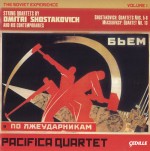 The two-CD set The Soviet Experience Volume 1 is the first in a series on Chicago’s excellent Cedille label devoted to String Quartets of Dmitri Shostakovich and his Contemporaries (Cedille CDR 90000 127). I can think of few quartets that are as immediately recognizable as those of Shostakovich, and of no music that is more imbued with personal pain and a sense of utter resignation, together with a heart-breaking sense of nostalgia for better days, now long gone. Listening to his music often seems like eavesdropping on a private and intimate conversation. The Pacifica Quartet performed the complete Shostakovich cycle in five Chicago concerts over a four-month period in 2010/11 as part of The Soviet Arts Experience, a 16-month-long project showcasing artists who worked in the old Soviet Union, and they have obviously developed a deep understanding of these works. The four quartets Nos. 5 to 8 are included on this first volume and the Pacifica members are terrific throughout, scaling the heights of the music as convincingly as they plumb the depths. The overwhelmingly autobiographical – and achingly personal – Quartet No.8 Op.110 is particularly effective.
The two-CD set The Soviet Experience Volume 1 is the first in a series on Chicago’s excellent Cedille label devoted to String Quartets of Dmitri Shostakovich and his Contemporaries (Cedille CDR 90000 127). I can think of few quartets that are as immediately recognizable as those of Shostakovich, and of no music that is more imbued with personal pain and a sense of utter resignation, together with a heart-breaking sense of nostalgia for better days, now long gone. Listening to his music often seems like eavesdropping on a private and intimate conversation. The Pacifica Quartet performed the complete Shostakovich cycle in five Chicago concerts over a four-month period in 2010/11 as part of The Soviet Arts Experience, a 16-month-long project showcasing artists who worked in the old Soviet Union, and they have obviously developed a deep understanding of these works. The four quartets Nos. 5 to 8 are included on this first volume and the Pacifica members are terrific throughout, scaling the heights of the music as convincingly as they plumb the depths. The overwhelmingly autobiographical – and achingly personal – Quartet No.8 Op.110 is particularly effective.
Nikolai Miaskovsky was 25 years older than Shostakovich, but was also included in the notorious 1948 Zhdanov decree that accused many of the Soviet Union’s leading composers of “formalism.” He was 36 when the 1917 Revolution took place, and, as the excellent booklet notes by William Hussey point out, was the only major Soviet composer who was also a member of the pre-Revolution generation of Tchaikovsky and Rimsky-Korsakov. His String Quartet No.13 in A Minor was written in 1950, not long before his death, and – not surprisingly, given the circumstances – in a fairly conservative style. If it has nowhere near the personal depth of the Shostakovich quartets, it’s still a fine work and receives an equally fine performance here.
Presumably, the complete cycle will be made available on CD before too long. If this first volume is anything to go by, it will be a significant addition to the Shostakovich catalogue.
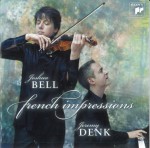 French Impressions is the title of the latest CD from Joshua Bell and Jeremy Denk (Sony Classical 88697 82026 2). At first sight, it seems slightly misleading, as the Ravel sonata is the only Impressionist work on the disc; the other two works are the Violin Sonata No.1 of Camille Saint-Saëns and the Sonata in A Major of César Franck. On first hearing, however, the title makes more sense. These are all works that invite flashy virtuosity, but although the virtuosity is clearly present the “flash” is absent; instead, the technical assurance is combined with an expressiveness and a musical maturity that presents all three works in a thoughtful, illuminating manner. The clue to this approach lies in the informal but very informative booklet notes, where Jeremy Denk considers what makes French music French: “sounds that float, hover, harmony like a scent, a perfume evaporating into air.” Add his comments about light and color, and it becomes clear that the performers are concerned more with impressions here than with virtuosity. The Saint-Saëns sonata is the one with the dazzling finale full of cascading octave runs, and while Bell might not be quite as hair-raising as James Ehnes in this movement, it’s perfectly balanced with the rest of the sonata. The Franck, so familiar as to easily risk becoming stale in the wrong hands, is beautifully judged, with some particularly outstanding piano playing from Denk, and the Ravel is a delight from start to finish. Bell plays brilliantly and intelligently, with a great tone and lovely phrasing, but never a hint of virtuosity for its own sake; Denk is simply stunning at the piano. The balance and recorded sound are excellent.
French Impressions is the title of the latest CD from Joshua Bell and Jeremy Denk (Sony Classical 88697 82026 2). At first sight, it seems slightly misleading, as the Ravel sonata is the only Impressionist work on the disc; the other two works are the Violin Sonata No.1 of Camille Saint-Saëns and the Sonata in A Major of César Franck. On first hearing, however, the title makes more sense. These are all works that invite flashy virtuosity, but although the virtuosity is clearly present the “flash” is absent; instead, the technical assurance is combined with an expressiveness and a musical maturity that presents all three works in a thoughtful, illuminating manner. The clue to this approach lies in the informal but very informative booklet notes, where Jeremy Denk considers what makes French music French: “sounds that float, hover, harmony like a scent, a perfume evaporating into air.” Add his comments about light and color, and it becomes clear that the performers are concerned more with impressions here than with virtuosity. The Saint-Saëns sonata is the one with the dazzling finale full of cascading octave runs, and while Bell might not be quite as hair-raising as James Ehnes in this movement, it’s perfectly balanced with the rest of the sonata. The Franck, so familiar as to easily risk becoming stale in the wrong hands, is beautifully judged, with some particularly outstanding piano playing from Denk, and the Ravel is a delight from start to finish. Bell plays brilliantly and intelligently, with a great tone and lovely phrasing, but never a hint of virtuosity for its own sake; Denk is simply stunning at the piano. The balance and recorded sound are excellent.
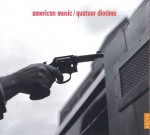 There is a startling mixture of compositional styles on American Music, the new CD from the French ensemble Quatuor Diotima that features string quartets by Steve Reich, Samuel Barber and George Crumb (naïve V 5272). Reich’s Different Trains for string quartet and tape, from 1988, was inspired by the childhood railway journeys he made with his governess between 1939 and 1942. Struck by how different the circumstances and experience would have been for a Jew riding on trains in Europe at that time, he conceived a work that combined a pre-recording of the quartet with train sounds from the period and with snippets of the recorded voices of his old governess and survivors of the Holocaust.
There is a startling mixture of compositional styles on American Music, the new CD from the French ensemble Quatuor Diotima that features string quartets by Steve Reich, Samuel Barber and George Crumb (naïve V 5272). Reich’s Different Trains for string quartet and tape, from 1988, was inspired by the childhood railway journeys he made with his governess between 1939 and 1942. Struck by how different the circumstances and experience would have been for a Jew riding on trains in Europe at that time, he conceived a work that combined a pre-recording of the quartet with train sounds from the period and with snippets of the recorded voices of his old governess and survivors of the Holocaust.
The three movements are “America – Before the War,” “Europe – During the War,” and “After the War,” but while Reich’s minimalist-driven style successfully creates a sense of mechanical perpetual motion, and while the instrumental doubling of the vocal scraps is very effective, I couldn’t help feeling that the middle movement failed to create an emotional centre for the work. For a middle movement that not only serves as the focal point of the work but also assumes a life of its own, you need look no further than Barber’s String Quartet in B Minor Op.11; the Molto adagio second movement became one of the most popular and widely-performed pieces of all time when the composer transcribed it as his Adagio for Strings. It’s certainly interesting to hear it in its original form and context, especially when the performance is as sensitive and as understated as it is here. It’s impossible to imagine any work farther away from the Barber than Crumb’s Black Angels for electric quartet, and what a startlingly original and stunning soundscape it is! Written in 1970 and subtitled 13 Images from the Dark Land, it requires the performers to use extended playing techniques as well as to play other instruments (glass rods, crystal glasses, maracas, tam-tams) and occasionally to use their own voices. The thirteen short sections are divided into three movements: I. Departure; II. Absence; and III. Return. The booklet notes call it “a deathly ceremonial, a sort of black mass,” and there are constant musical references to Death, Hell (the Dark Land) and the Devil throughout the work. The quartet’s construction is apparently governed by numerology – in particular the numbers 7 and 13 – but Crumb has increasingly played down their significance since 1970. It’s a simply astonishing work, complex and difficult enough to make any objective review of the performance – in comparison, say, to the Kronos Quartet’s performance – almost impossible, and certainly irrelevant. Suffice it to say that it’s a stunning aural and musical experience.
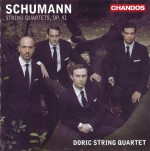 Robert Schumann, more than any other composer, chose to concentrate on one particular form of composition at a time. 1842 was devoted to chamber music, and his three String Quartets, Op. 41 were written in a matter of eight weeks in the middle of the year, after he had spent several months studying the quartets of Haydn, Mozart and – in particular – Beethoven. The influence of the latter is easy to hear, but the voice that really leaps out at you on a new CD from the Doric String Quartet (Chandos CHAN 10692) is that of Mendelssohn, to whom the quartets were dedicated on their publication in 1848. These are top-notch performances in all respects, but the Doric Quartet is particularly outstanding in the Mendelssohn-like scherzo movements, where their articulation, ensemble playing and dynamics in the scurrying passages are simply superb. There’s some rather obtrusive breathing in the slower movements, but not enough to detract from a terrific CD.
Robert Schumann, more than any other composer, chose to concentrate on one particular form of composition at a time. 1842 was devoted to chamber music, and his three String Quartets, Op. 41 were written in a matter of eight weeks in the middle of the year, after he had spent several months studying the quartets of Haydn, Mozart and – in particular – Beethoven. The influence of the latter is easy to hear, but the voice that really leaps out at you on a new CD from the Doric String Quartet (Chandos CHAN 10692) is that of Mendelssohn, to whom the quartets were dedicated on their publication in 1848. These are top-notch performances in all respects, but the Doric Quartet is particularly outstanding in the Mendelssohn-like scherzo movements, where their articulation, ensemble playing and dynamics in the scurrying passages are simply superb. There’s some rather obtrusive breathing in the slower movements, but not enough to detract from a terrific CD.
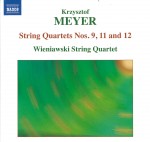 Naxos has added another excellent CD to its already outstanding catalogue of contemporary string quartets with the Wieniawski Quartet’s performances of the String Quartets Nos. 9, 11 and 12 by Polish composer Krzysztof Meyer (Naxos 8.572656). Meyer, born in 1943, was a student of Penderecki and is a recognized authority on the life and works of Shostakovich. There is more than a hint of the Soviet composer in Meyer’s quartets, but there is also no doubting that there is a highly competent and individual craftsman at work here. Meyer’s ongoing series of string quartets currently stands at 12 works and covers 42 years, from 1963 to 2005. Quartet No.9 dates from 1990 and No.11 from 2001. All three works on this CD are quite different in form: No.9 is in five movements; No.11 is a single-movement work; No.12 is nine mostly short movements joined together in a manner similar to Beethoven’s Quartet in C-Sharp Minor Op.131. Meyer employs a range of compositional techniques, but you’re never aware of them; these quartets are always accessible, engrossing and highly effective. It would be difficult to imagine more suitable interpreters of these works than the all-Polish Wieniawski Quartet, who have been together for 15 years. Their playing is exemplary in all respects. They have already recorded Quartets Nos. 5, 6 and 8 for Naxos (8.570776). “Intensely dramatic and eloquent,” says the jewel case blurb in describing these works and they are exactly that. The recorded sound is excellent, the booklet notes adequate but somewhat technical in nature. At the bargain Naxos price, these discs are a terrific buy.
Naxos has added another excellent CD to its already outstanding catalogue of contemporary string quartets with the Wieniawski Quartet’s performances of the String Quartets Nos. 9, 11 and 12 by Polish composer Krzysztof Meyer (Naxos 8.572656). Meyer, born in 1943, was a student of Penderecki and is a recognized authority on the life and works of Shostakovich. There is more than a hint of the Soviet composer in Meyer’s quartets, but there is also no doubting that there is a highly competent and individual craftsman at work here. Meyer’s ongoing series of string quartets currently stands at 12 works and covers 42 years, from 1963 to 2005. Quartet No.9 dates from 1990 and No.11 from 2001. All three works on this CD are quite different in form: No.9 is in five movements; No.11 is a single-movement work; No.12 is nine mostly short movements joined together in a manner similar to Beethoven’s Quartet in C-Sharp Minor Op.131. Meyer employs a range of compositional techniques, but you’re never aware of them; these quartets are always accessible, engrossing and highly effective. It would be difficult to imagine more suitable interpreters of these works than the all-Polish Wieniawski Quartet, who have been together for 15 years. Their playing is exemplary in all respects. They have already recorded Quartets Nos. 5, 6 and 8 for Naxos (8.570776). “Intensely dramatic and eloquent,” says the jewel case blurb in describing these works and they are exactly that. The recorded sound is excellent, the booklet notes adequate but somewhat technical in nature. At the bargain Naxos price, these discs are a terrific buy.
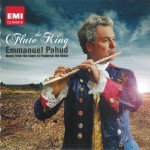 The Flute King - Music from the Court of Frederick the Great
The Flute King - Music from the Court of Frederick the Great

